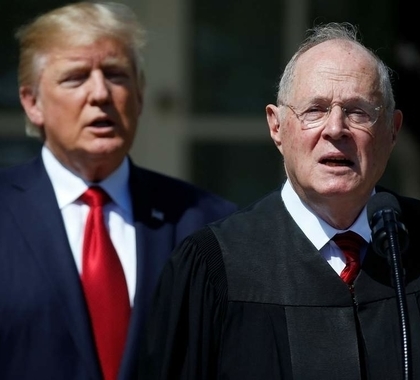Washington is abuzz over the retirement of Supreme Court Justice Anthony Kennedy. Filling this US Supreme Court vacancy could very well be the most crucial presidential appointment in America’s history. The pressure on President Trump from the Liberal Democrats, the left-wing media and the “Never Trump” Republicans to put another moderate like Kennedy on the high court will be like nothing Donald Trump nor we have ever seen before.
We now have a once-in-a-lifetime opportunity to lock the Leftists out of power on the Supreme Court, to rein in the out-of-control judiciary and preserve the sanctity of human life. It is certain that liberals and the “never-Trump” Republicans are preparing to spend millions and millions to defeat any pro-life conservative President Trump nominates. Their goal is to first intimidate Donald Trump into appointing a wishy-washy “moderate” like Anthony Kennedy. If that doesn’t work, they plan to personally destroy any pro-life conservative the President nominates.
Legacy of Kennedy
While some have called Kennedy a moderate voice on the bench, his record shows he’s been a primary force for progressives, giving liberals numerous wins on the social issues that have discouraged many American Christians for decades. Kennedy was not Ronald Reagan’s first choice for the Supreme Court – he was his third. Kennedy became a justice on the highest court in the land after the Senate rejected Judge Robert Bork – Reagan’s first choice – and after his second choice, Judge Douglas Ginsburg, withdrew his name. Reagan likely never anticipated the crucial tie-breaker role that Kennedy would come to fill on the court, or the way he would propel gay rights and abortion rights forward.
Justice Kennedy informed his colleagues of his plans to retire on Wednesday, June 27. He then visited the White House to meet with Trump, where they talked for half an hour about a potential successor and other topics. Kennedy’s retirement will take effect on July 31st.
Without Kennedy, the court will be split between four liberal justices who were appointed by Democratic presidents and four conservatives who were named by Republicans. Trump’s nominee will likely give the conservatives a solid majority and will face a Senate confirmation process in which Republicans hold the slimmest majority, but Democrats can’t prevent a vote.
Justification to confirm SC nominee before mid-terms
As could be expected, ever since Justice Kennedy announced his retirement, the left has been in an uproar screeching that Trump needs to hold off on his appointments till after the midterms, citing the blockage of Merrick Garland when Obama tried to appoint Garland before the 2016 presidential election. Listen here to the Liberal meltdown over the announcement of Kennedy’s retirement, as talk show hosts on CNN, MSNBC, The View, and other celebrities, spew their hatred over the untenable idea that President Trump will choose Kennedy’s replacement.
As to the Merrick Garland argument, it fails to carry any weight. In 2010 Obama appointed Elana Kagan right before the 2010 midterm election, and the Republicans allowed it. Senate Republicans do plan to move quickly before November’s midterm elections.
Following Kennedy’ announcement on Wednesday, June 27, Senate Majority Leader Mitch McConnell, when asked if he thinks it’s fair to push for a confirmation before the midterms after his blockage of Garland, he replied, “There’s no presidential election this year.” Judiciary Committee Chairman Chuck Grassley, R-Iowa, also pointed to the fact that Obama appointed Justice Elena Kagan to the court during a midterm year in 2010. She was confirmed a few months before the elections.
Of greater concern is whether Republican senators can unite to confirm Trump’s Supreme Court’s nominee before the mid-term elections. In theory, Republicans, with 51 seats, can afford one defection and let Vice President Mike Pence cast the tie breaking vote; however, Susan Collins (R-ME), Lisa Murkowski (R-AK) and even Lindsey Graham has expressed doubt over whether he would be comfortable voting to confirm a pro-life Supreme Court Justice. There is also the issue of Arizona Sen. John McCain, suffering from brain cancer, has not been in Washington for months.
Selection of judges now and in Reagan’s time
Following is an excerpt from a commentary shared by Joseph A. Morris upon Justice Kennedy’s retirement. Mr. Morris is a Partner in the law firm of Morris & De La Rosa, with offices in Chicago and London. He maintains an active practice conducting trials and appeals in the areas of constitutional, business, labor and international law. He is a member of the Bars of the Supreme Court of the United States, the Supreme Court of Illinois and several other courts. Morris also served in President Reagan’s administration as Assistant Attorney General (under Attorney General Meese). Joseph A. Morris is a member of the Chicago Lawyers Chapter of the Federalist Society.
“When, 37 years ago, President Reagan went shopping for a nominee for his first Supreme Court appointment, there was no Federalist Society to offer recommendations, no Heritage Foundation list to consult.
When the President Reagan went asking about candidates, he naturally turned to then-Associate Justice William Rehnquist, the top conservative jurist of the day. Justice Rehnquist recommended Sandra Day O’Connor, who had been an Arizona State legislator and was an Arizona appellate judge. He had known her as a solid Republican in his home State (and, in fact, had gone to law school with her at Stanford University) and knew her to be smart, industrious, and as conservative as judicial conservativism could be defined in that day. [Considered a federalist and a moderate Republican, O’Connor tended to approach each case narrowly without arguing for sweeping precedents. She most frequently sided with the Court’s conservative bloc, although in the latter years of her tenure, she was regarded as having the swing opinion in many cases.]
With the tools that the Federalist Society, the Heritage Foundation, the Cato Institute, and numerous others have devised to keep track of and to evaluate the public work of judges, we can now be far more confident of the views of judicial candidates than ever before. We now know not just how to look for their sympathies, prejudices, and friendships, so to speak, but we can also see how their minds actually work: How they analyze questions, read texts, and reason their ways to decisions.”
According to Joseph A. Morris, “President Trump has approached his duty to appoint, and to prepare to appoint, justices to the United States Supreme Court with unprecedented transparency. His first lists of potential nominees were released during the election campaign of 2016 (and included the name of now-Justice Gorsuch). His most recent list, which takes on special significance given the delivery yesterday to the President of Justice Kennedy’s letter of retirement (effective July 31, 2018), was publicly issued by the White House on November 17, 2017. The names on the list are set forth in alphabetical order.”
Trump’s five front runners
The Washington Times on Wednesday, June 27, 2018, reported that, according to Fox News, President Trump has five front runners in mind to replace Supreme Court Justice Anthony M. Kennedy. These five names are from the just cited of roughly 25 judicial nominees compiled by the Heritage Foundation and the Federalist Society during Trump’s campaign. The five are: D.C. Circuit Judge Brett Kavanaugh, who was appointed by President George W. Bush; Judge Amy Coney Barrett of the 7th U.S. Circuit Court of Appeals who Mr. Trumpnominated last year; Judge Thomas Hardiman of the 3rd Circuit who was nominated by President George W. Bush; and Judges Amul Thapar and Raymond Kethledge both from the 6th Circuit.
Evangelicals want Trump to pick Amy Coney Barrett. She is also high on the list for Joseph A. Morris. Barrett studied law at Notre Dame with Charlie Rice; she clerked at the D.C. Circuit for Lawrence Silberman; then she clerked at the Supreme Court for Antonin Scalia. That’s about as good as a lawyer’s pedigree can get. She’s only 45; she’s a serious Catholic; she’s happily married; and she’s the mother of seven children. During her confirmation hearings for the Seventh Circuit, Senator Durbin and Senator Feinstein made fools of themselves attacking her for her religious beliefs (“too extreme”; “dangerous”) despite the No Religious Tests Clause of the Constitution.
Comments by Andy Schlafly, son of Phyllis Schlafly, leading conservativevoice in the late 20th century
Andy Schlafly, Esq, expressed his misgivings about two of the front runner candidates in an e-mail shared with Phyllis Schlafly Eagles:
- “Thapar is on the list because he’s McConnell’s close friend, who even got Trump to interview Thapar for the last Supreme Court vacancy. Thapar was then the first judge McConnell confirmed for the Court of Appeals. Thapar is best known for sentencing an 84-year-old nun to 3 years in prison for a political protest. His ruling was reversed.”
- Kethledge is not pro-life either. He has never issued a pro-life ruling, and he even joined a decision that favorably cited a case which censored a pro-life advertisement”
Andy Schlafly further stated: “Let’s not fall for McConnell pretending that only he can confirm a nominee. I’d rather have Kennedy’s seat go vacant through the election than have McConnell put someone on who is not pro-life. Trump’s nominees will get a vote with or without McConnell, before or after the election, and what matters most is that Trump’s pro-life pledge be honored. We did well in the last election because there was an unfilled vacancy, and we should not accept a stealth pro-abort pick to appease McConnell and other pro-abort Republicans.
What if the shoe were on the other foot?
President Trump will release the name of his Supreme Court Nominee on Monday, July 9th. In an appeared on Real Time with Bill Maher, Michael Mooreurged fellow liberals not to give up hope on the inevitable confirmation of President Donald Trump’s Supreme Court nominee. He vowed to surround the U.S. capitol with a million other people to stop Trump’s SCOTUS confirmation.
Expect the post 4th of July fireworks to begin in earnest on July 9th. I can’t help wondering how different things would be if the shoe were on the other foot and Kennedy’s replacement would be the prerogative of a Democrat president.
[Originally Published at Illinois Review]



